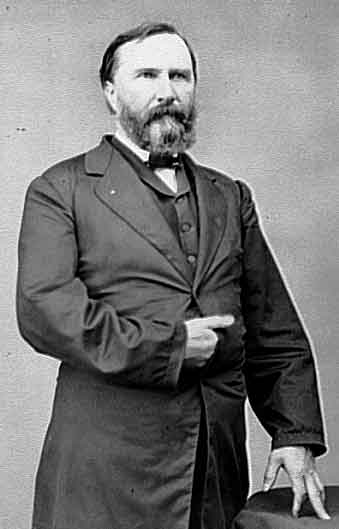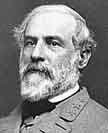|
|
|
|
|
(cwp 4a40265) |
|
|
|
|
|
(cwp 4a40265) |
The death of Stonewall Jackson several months before Gettysburg left a large hole in General Lee's command structure. It was not just Jackson's ability as a slashing attacker. The personalities and styles of the Army of Northern Virginia's (ANV) commanders had meshed very well before Gettysburg. Lee would set a broad plan and delegate. Stonewall was an aggressive Corps commander, who often took half Lee's army into semi-independent operation. While dividing an army risks defeat in detail, Lee and Jackson consistently and effectively took this risk. Lee felt the smaller army had to take risks to achieve victory. Until Gettysburg, most of Lee's gambles had paid off. Lee's and Jackson's aggressive, unorthodox command style drove the Union commanders into a defensive shell. During the mid war period, until the arrival of U. S. Grant, the Army of Northern Virginia held the initiative almost out of habit.
If Stonewall was Lee's hammer, Longstreet was his anvil. Longstreet was thorough, dependable and careful. He might have been a bit slow, at least in comparison with Stonewall Jackson. In another respect, Longstreet was ahead of his time. He had already figured out that the weapons of the time gave the advantage to a defending force well dug in on high ground. It seems half the generals of World War I never figured out what Longstreet already knew at Gettysburg, the power of the defensive.
Grant and the Army of the Potomac learned this lesson in earnest just before Petersburg. At a northern war council, much of the Union high command was trying to figure out how to prevent the enlisted men from digging trenches and foxholes when they got too close to the enemy. Grant ended the discussion with an order to distribute shovels. The result was the siege of Petersburg, a preview of World War I trench warfare. During the Gettysburg campaign, Longstreet was already advocating the tactical defensive, and strove to avoid assaults on high prepared positions. While Longstreet was correct in terms of terrain and weapons, this defensive approach conflicted with Lee's and Jackson's more aggressive style, and the idea that the smaller force must take the risks. Lee preferred maneuver warfare.
On days two and three at Gettysburg, Lee tried to use his anvil as a hammer. Twice, Lee ordered Longstreet to make attacks he would have preferred to avoid. Ordered to attack, Longstreet organized thorough and hard strikes, both of which failed. Longstreet clearly anticipated Pickett's charge would fail. Lee knew this. He still thought Longstreet was his best man to organize the attacks.
The other aspect of the missing Stonewall Jackson was that Ewell and A.P. Hill were new to Corps command. Both had worked well under Jackson. However, if Jackson worked very well when Lee gave him vague strategy and considerable freedom, Jackson did not pass this freedom down to his subordinates. They were accustomed to explicit directions with no elaboration. Thus, Hill and Ewell might have been expecting more definite direction from Lee. Thus, all three southern Corps commanders were in uncomfortable positions. The formidable command structure of the Army of Northern Virginia had been reshuffled. It was unable to resort itself under fire.
|
"If he is there tomorrow, it will be because he wants you to attack him." |
 |
|
(cwp 4a40374) |
In the feuding among southern commanders that developed after Lee's death, two accounts of southern strategy for the Gettysburg campaign were given. Longstreet described an approach of being "offensive in strategy but defensive in tactics." The ANV would advance into northern territory, disperse to acquire supply, but concentrate on good defensive ground upon the approach of the northern army. This was likely Longstreet's vision, a vision echoed by the northern commanders. However, Lee did not use defensive tactics. The north ended up concentrated on the high ground. The south had the initiative, and the more difficult supply situation. Thus, they had the requirement to attack.
The second version of Lee's strategy was put forth by Longstreet's detractors. It meshes better with Lee's actions through the campaign. This version had the south on the offensive both strategically and tactically. By marching unobserved behind the mountains, Lee hoped to get well ahead of the Army of the Potomac. The northerners would have to perform forced marches to catch up. Lee hoped to have a moderately rested and concentrated ANV waiting for dispersed and exhausted Union columns. He hoped to defeat several of these columns in detail, before they could join to form a unified force. Clearly, if this was Lee's objective, he could not select ground and wait on the defensive. He had to maneuver against his opponents, and remain aggressive.
The third version of Lee's strategy is found in General Lee's own report of the battle. Lee never intended to offer general battle so far from his base of supply. There is good reason for this. Even if a clean victory could be achieved, after expending the ammunition necessary for a general battle Civil War era armies had to retreat to a good base of supply before they fought again. Even if a battle was won, if one was forced to retreat for logistical purposes, the impression given would be of a defeat. Thus, Lee did not go north to force an offensive general battle, nor to force a defensive general battle, but was raiding, was attempting to avoid battle, fighting on the morale and economic levels. The intent was to force Lincoln out of office in the 1864 elections.
 |
"It had not been intended to deliver a general battle so far from our base unless attacked, but coming unexpectedly upon the whole Federal army, to withdraw through the mountains with our extensive trains would have been difficult and dangerous. At the same time, we were unable to await an attack, as the country was unfavorable for collecting supplies in the presence of the enemy, who could restrain our foraging parties by holding the mountain-passes with local and other troops. A battle had, therefore, become in a musure unavoidable, and the success already gained gave hope of a favorable issue." |
Too many accounts of the Gettysburg campaign lock too tightly into one of the above three well documented but conflicting southern strategies. Which is the true strategy? I would trust Lee's account of Lee's strategy until June 28, when Longstreet's spy informed him that the Army of the Potomac was concentrated at Frederic. I would trust the aggressive attack of supposedly dispersed and exhausted Union columns strategy from the morning of July 2nd on. Clearly, by the morning of July 2nd, Lee had committed to the offensive. Some time between June 28 and July 2nd, Lee decided a general battle could not be avoided, and thus general battle would have to be won. If nothing else, the AoP would have to be crippled to the point that it could not effectively prevent a ANV retreat back to Virginia.
How had circumstances changed?
Lee's other problem was his cavalry screen. General Jeb Stuart had orders which allowed and encouraged an easterly route to the Gettysburg area. The conventional deployment would keep Stuart's cavalry between the two armies. Lee and Longstreet gave orders suggesting an easterly route that put both South Mountain and the Army of the Potomac between Stuart and Lee. The stated motive for this route was to avoid telegraphing southern intentions. While Stuart is traditionally blamed by historians for making a "joyride" and exceeding his orders, this accusation is questionable. Still, numerous Union formations blocked Stuart's routes back to Lee. His rendezvous with Lee was late. He was out of contact with infantry for eight days, rather than the expected four. The ANV was thus short on information in the critical days before contact. If Lee's plan was to defeat scattered and exhausted Union columns, this lack of scouting information may have proved fatal. Lee was late in concentrating, and had no better information on Union positions than they had of Lee's. While Lee was better concentrated on the first day, he required long marches to achieve this. Lee's army was not much better rested than the Union's, and had to assume the more energetic offensive role.
The lack of scouting information also likely contributed to "do not bring on a general engagement" orders by Lee to Ewell and Hill on the first day at Gettysburg. While Ewell and Hill have been criticized for a lack of aggression, their orders from Lee were tentative. They were to avoid general engagements. They were to take Cemetery and Culp's hills, "if practical." My own reading of the orders is that Lee didn't want to strike until he was fully concentrated. By striking early, Ewell and Hill won a minor victory on July 1st, but not a decisive victory. Lee did not have sufficient reserves, given the unknown position of the rest of the AoP, to push for decisive victory late on July 1st. He dared not commit his last available fresh troops given he hadn't accounted for five corps of Union infantry.
Gettysburg has been described as a meeting encounter. Neither army really intended to fight there. However, on learning of the approach of the Union Army, Gettysburg was a road center roughly equidistant from Lee's scattered infantry units. It was there that he directed Longstreet, Ewell and Hill to converge. The Union was already there.
Next: The Northern March